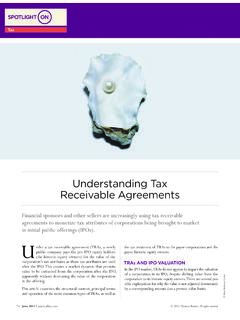Transcription of Wachtell, Lipton, Rosen & Katz
1 Wachtell, Lipton, Rosen & Katz Spin-Off guide 2020. April 2020. Wachtell, Lipton, Rosen & Katz All rights reserved. Spin-Off guide TABLE OF CONTENTS. Page I. Overview ..1. II. Initial Planning Considerations ..3. A. Reasons for Spin-Offs ..3. B. Separation Transaction Structures ..4. 1. 100% 2. Partial Spin-Off ..6. 3. IPO Plus Spin-Off / The Up-C Structure ..6. 4. IPO Plus Split-Off / Split-Off to Large Stockholder ..8. 5. Sponsored Spin-Offs ..9. 6. Spin-Offs Combined with M&A 7. REIT Separation C. Internal Process Considerations ..11. III. General Separation Issues ..13. A. Identification and Grouping of Businesses ..13. B. Capital Structure Considerations ..14. C. Allocation of Other Liabilities ..17. D. Solvency and E. Governance Considerations ..18. -i- 1. Duties of the Parent Board.
2 18. 2. Corporate and Governance Structuring of the Spin-Off Company ..19. 3. Takeover Defenses ..21. 4. Governance Following a Carve-Out IPO ..24. F. Management and Employee Matters ..26. 1. Composition of Employees ..26. 2. Allocation of Employee Benefits ..26. 3. Adjustments to Equity-Based Compensation Awards ..27. G. Consent Requirements ..28. H. Antitrust ..29. I. Intellectual Property ..29. J. Related-Party Arrangements ..29. K. Initial Disclosure of the Spin-Off ..30. L. Shareholder Vote ..31. IV. Transaction Agreements ..33. A. Generally ..33. B. Separation and Distribution C. Transition Services Agreement ..36. D. Tax Matters Agreement ..36. E. Employee Matters Agreement ..37. V. Securities Law -ii- A. Principal Securities Law Filings ..39. B. Eligibility of Subsidiary to Use Form S-3.
3 43. C. Emerging Growth Company Status ..44. D. Other SEC Filings ..44. E. Obligations upon Effectiveness of the Registration F. Investor Relations Activities ..47. VI. Tax Issues ..49. A. Generally ..49. 1. Requirements for Tax-Free Treatment ..49. 2. Procedural Considerations ..51. B. Spin-Offs Followed by Acquisitions ..53. VII. Listing and Trading Considerations ..55. A. Stock Exchange Listing ..55. B. When-Issued Trading ..55. C. The Distribution Ratio ..56. D. Reverse Stock Splits ..56. Annex A Illustrative Sample Timetable for a Spin-Off Annex B Post-Spin Limitations on Strategic Transactions -iii- I. Overview A spin-off involves the separation of a company's businesses through the creation of one or more separate, publicly traded companies. Spin-offs have been popular because many investors, boards and managers believe that certain businesses may command higher valuations if owned and managed separately, rather than as part of the same enterprise.
4 An added benefit is that a spin-off can often be accomplished in a manner that is tax-free to both the existing public company (referred to as the parent) and its shareholders. Companies have also been able to tap the debt markets to lock in low borrowing costs for the business being separated and monetize a portion of its value. Spin-offs continue to be an important option that companies evaluate when assessing go-forward strategies: the total volume of completed spin-offs reached $179 billion in 2019, compared to $73. billion in 2018. However, as of this writing, the COVID-19 pandemic is having a significant impact on transaction activity, and it remains to be seen how it will affect spin-off activity. The process of completing a spin-off is complex. The issues that arise in an individual situation depend largely on the business goals of the separation transaction, the degree to which the businesses were integrated before the transaction, the extent of the continuing relationships between the businesses after the transaction, the structure of the transaction and the desire to obtain (if possible).
5 Tax-free treatment of the spin-off. If the businesses were tightly integrated before the transaction or are expected to have significant business relationships following the transaction, it will take more time and effort to allocate assets and liabilities, identify personnel that will be transferred, separate employee benefits plans, obtain consents relating to contracts and other rights, and document ongoing arrangements for shared services ( , legal, finance, human resources and information technology) and continuing supply, intellectual property sharing and other commercial or operating agreements. If the parent is expected to own a substantial portion of the spin-off company after the closing, careful planning is also required with respect to the composition of the new company's board, independent director approval of related-party transactions, handling of corporate opportunities and other matters.
6 In addition to these separation-related issues, spin-offs raise various issues associated with taking a company public, such as drafting and filing the initial disclosure documents, applying for listing on a stock exchange, implementing internal controls and managing ongoing reporting obligations and public investor relations. These issues become more complex in a spin-off -1- combined with an initial public offering or other capital markets transaction, or in a spin-off that is part of a larger merger or business combination. This guide is intended to help navigate the spin-off process, from the preliminary phases through completion of the transaction. Part II of this guide describes some of the initial planning considerations relating to spin-offs, and includes a discussion of the principal reasons for spin-offs and a comparison to other separation transactions.
7 Part III examines a broad array of general corporate separation issues that may arise in a spin-off. Part IV discusses the transaction agreements commonly executed to implement a spin-off and govern the post-spin relationship between the parent and the spin-off company. Part V identifies the principal securities law matters associated with a spin-off. Part VI examines certain tax issues, which are critical given the tax-sensitive nature of separation transactions. Finally, Part VII reviews stock exchange listing and trading considerations. A sample illustrative timetable for a spin-off (that is not preceded by an initial public offering) is attached as Annex A. A discussion of post-spin limitations on strategic transactions is attached as Annex B. This edition of the guide reflects developments through April 2020.
8 -2- II. Initial Planning Considerations A. Reasons for Spin-Offs There are several drivers of spin-off activity. The principal reasons often cited by companies for pursuing spin-offs include the following: Enhanced business focus. A spin-off will allow each business to focus on its own strategic and operational plans without diverting human and financial resources from the other business. Business-appropriate capital structure. A spin-off will enable each business to pursue the capital structure that is most appropriate for its business, strategy, and growth or cash flow profile. Each business may have different capital requirements that may not be optimally addressed with a single capital structure. Distinct investment identity. A spin-off will create distinct and targeted investment opportunities in each business.
9 A more pure-play . company may be considered more transparent and attractive to investors focused on a particular sector or growth strategy, thereby counteracting the conglomerate discount and enhancing the value of the business. Effectiveness of equity-based compensation. A spin-off will increase the effectiveness of the equity-based compensation programs of both businesses by tying the value of the equity compensation awarded to employees, officers and directors more directly to the performance of the business for which these individuals provide services. Use of equity as acquisition currency. By creating a separately publicly traded stock for part of the parent company's businesses, a spin-off will enhance the ability of both the parent and the spin-off company to effect acquisitions using its stock as consideration.
10 Shareholder activism is another potential driver of spin-off activity. Shareholder activists have become a powerful force in the corporate landscape, and many activists agitate for value maximizing activity, including spin-offs. For example, Trian Fund Management ran a proxy fight for board representation at DuPont in 2015 and campaigned for a spin-off of DuPont's agriculture, health and industrial biosciences businesses. Although Trian did not win board representation, -3- DuPont several months later agreed to merge with The Dow Chemical Company, which had also faced pressure from activist Third Point, and the two agreed that post-merger, they would separate into three new companies an agricultural chemicals company, a material sciences company and a specialty products company.






